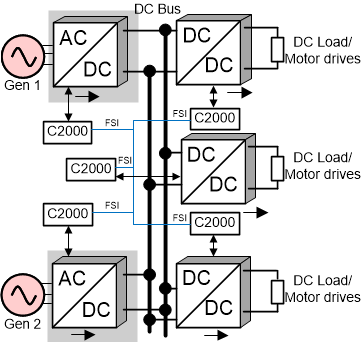SPRACR6 April 2020 F29H850TU , F29H859TU-Q1 , TMS320F280023-Q1 , TMS320F280023C , TMS320F280025C , TMS320F280025C-Q1 , TMS320F280041-Q1 , TMS320F280041C , TMS320F280041C-Q1 , TMS320F280048-Q1 , TMS320F280048C-Q1 , TMS320F280049-Q1 , TMS320F280049C , TMS320F280049C-Q1 , TMS320F28384D , TMS320F28384D-Q1 , TMS320F28384S , TMS320F28384S-Q1 , TMS320F28386D , TMS320F28386D-Q1 , TMS320F28386S , TMS320F28386S-Q1 , TMS320F28388D , TMS320F28388S , TMS320F28P650DH , TMS320F28P650DK , TMS320F28P650SH , TMS320F28P650SK , TMS320F28P659DH-Q1 , TMS320F28P659DK-Q1 , TMS320F28P659SH-Q1
2.3 Distributed Power Control Architecture – DC/DC System
Figure 6 illustrates a DC distribution [4] used in many industrial systems. Industrial plants demand highly reliable supply of power. The loads in these plants are sensitive to power supply disturbances. DC distribution addresses some of these challenges. Such dc systems use power converters to convert ac source(s) to dc and distribute the power using dc lines. DC/AC converters are used at the load end when it is required. For the motor type loads, driven by inverter drives, DC voltage is directly applied to drive inputs.
The power converters are the main components of such DC systems. The fast response capability of these converters facilitates use of alternate power sources to provide highly reliable supply of power. The alternate power sources in combination with power converters also provides a very effective method for meeting the ever-increasing high-power loads in certain applications such as, on ships that also need highly reliable and very high-quality power supply. For this kind of applications the conventional ac systems are very hard to maintain. The power converters in the DC system also provide very effective filtering against power disturbances. The fuel-cell technology is another driver for dc distribution, as the fuel cells produce dc power. Thus, the dc distribution becomes attractive for many industrial systems with heavy motor controlled loads and/or sensitive electronic loads.
 Figure 6. DC Distribution System in a DPCA Configuration
Figure 6. DC Distribution System in a DPCA Configuration Here again, multiple C2000 MCUs could be used to control the power converters, and then, all of the MCUs could be connected through the FSI ports for overall system management.